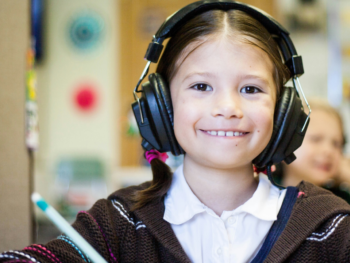Prepare your child for free online school.
Making the transition from a brick-and-mortar school to an online school can seem daunting. Your student will be learning in a whole new way, and you’ll be supporting them in a whole new way. While you’re sure to learn and grow with your student throughout the year, it never hurts to do a little planning. Below, we’ve listed our top five tips for helping your student prepare for an online school to help make things a little easier for both you and your student.
Create A Dedicated Workspace
If COVID-19 has led to remote work for you or virtual learning for your student, you probably already know how important having a dedicated workspace is. This is because we associate certain areas of our homes with certain activities and feelings. The bed is where your child relaxes and sleeps. The gaming desk is where they play video games and have fun with friends online. The living room couch is where they watch their favorite tv shows. If your child chooses a space where they’re used to having fun or resting as their work area, they’re likely going to lose focus. That is why it is important to create a dedicated workspace for your student in your home. They need to have a place that they associate with school work and productivity. Likewise, when your child is done with their school day, you want them to have a place where they can go to unwind. If their workspace and their relaxation space are the same, the lines between the two will continuously blur.
How do you create an energizing workspace?
- If possible, choose an area of your home that your student doesn’t associate with another activity.
- Remove any unnecessary clutter and household items from the workspace that may be distracting.
- If the space can be used as a permanent workspace, allow your student to house all of their school items there such as their school laptop, textbooks, folders, calendars, planners, pencils, pens, etc, and allow them to decorate the area. If you do not have an area of your home that you can convert into a permanent workspace for your child, instead have them set up and take down their workspace at the beginning and end of each school day.
- Make sure your student has a good WiFi connection in this area of your home.
- If you will be around during the school day, have the space in an area you will naturally be walking through so you can quickly check upon them.
- That being said, you should also try to eliminate the amount of traffic throughout the area. Make sure pets and siblings won’t be constantly walking in and out of the room, distracting your student.
Eliminate as Many Distractions as Possible
We have already discussed eliminating clutter and distracting items from the workspace as well as limiting interactions with siblings and pets. In addition to these items, consider the technology your student has access to. Your student most likely will not need their cell phone, tablet, or non-school computer/laptop during the day, so it may be best to limit access to these items during class time. If your student is using a household computer to attend classes and perform schoolwork, you may also want to consider putting parental controls on your student’s devices. If you need help setting those up, you can find some great information here.
Create a Schedule
If your student is attending a brick and mortar school that switched to digital learning due to COVID, they will most likely have a similar class schedule to when they attended school in person. That being said, since they don’t have to travel to get to class, their daily routine will be different. If your child falls into this category, set a time for them to get up each morning so they are prepared to start class. Rolling out of bed five minutes before class starts isn’t going to help them learn and digest the material.
The majority of actual online schools (not brick and mortar schools that have transitioned to virtual learning) do not require students to attend a class for 6-8 hours a day. Older students typically have 1-2 scheduled class periods a day which is supported by optional review periods where students can ask questions and receive further instruction from their teachers.
While this is fantastic for those who have unique or hard to accommodate schedules, some students find it challenging to get motivated when they do not have a complete set schedule every day.
This is where having a defined routine in place (and following it) is important. It doesn’t have to be as rigid as a typical school schedule. In fact, it probably shouldn’t be. It should be built with your student’s specific needs in mind. Things to consider are:
- When does your child learn the best? Are they an early riser or do they do better in the afternoon or evening?
- What is the best work-to-break ratio for your student? The ideal work to break ratio is said to be 52 minutes on, and 17 minutes off. But this can vary between age groups and everyone has different preferences, so don’t be afraid to branch away from this based on your child’s learning habits. If they are a quick learner and would prefer to power through a few lessons at a time, that is perfectly fine. If they have a hard time maintaining focus and need more frequent breaks to get out some of their energy, that is okay too. The important part is that a schedule is formed and followed.
- What other commitments does your student have? If your student has a job, participates in a sport or hobby, or has other responsibilities they need to attend to, make sure you build in time not just for them to take care of these things, but for them to transition from one task to the next. It may only take one minute for your student to get from the piano downstairs to their desk upstairs, but mentally transitioning from piano lessons to geometry may take a little longer.
At the end of the day, the most important thing is to build a schedule that supports the way your student learns. Whether that is six hours of back-to-back lessons or 20 minutes on five minutes off, doesn’t matter. What matters is building a schedule and sticking to it.
Don’t Be Afraid of Change
You’ve created a workspace, eliminated distractions, and set a schedule, so what’s next? Preparing yourself for change. You and your student most likely aren’t going to get everything right the first time around. Maybe your student thought they would be able to handle working from their room, but it turns out there are just too many distractions. Maybe you thought they would do well with morning classes, but it turns out they learn much better in the afternoon and evening. Whatever the change may be, don’t shy away from it. Online schooling is new for you and your student which means it is going to take time to get things right. Embrace that change so you and your student can create the best educational path for them.
Look for Socialization Opportunities
School is typically much more than a place to learn for kids. It is a place where they make friends, socialize with peers, and develop their social skills. And thankfully, this doesn’t change with online school. Many schools offer a number of social activities and events students can participate in. For example, here at Uplift Michigan, we offer:
- A variety of clubs based on student interests.
- Social hours where students can socialize, make friends, and learn about their classmates.
- Virtual and in-person field trips where students can learn in a more hands-on way.
That being said, it is still important for you, as a parent, to keep your eyes open for in-person social opportunities — especially with younger children. Make sure you are doing your part to set up playdates and help your child stay in touch with your friends. For older students, encourage participation in extracurriculars and events.
Build a Relationship with Your School and Teacher
At the end of the day, your online school and the people that teach there are going to be your best resource. They will be there every step of the way to help you and your student navigate the transition to online schooling. But they can’t help you at their best if you are not reaching out and asking any questions you may have. Try to build a strong relationship with your student's teachers so you can gain insight into how your student is performing outside of just a grade on a sheet of paper. This relationship will also allow you to convey any concerns or challenges your student may have and will give the teacher the opportunity to personally address them.
Not Yet Enrolled in Online School?
If you’re still searching for the right Michigan Online School for your student, consider taking a look at Uplift Michigan. We’re a free, public online school serving students all over Michigan and we’d love to hear from you!






